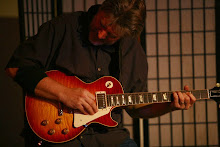wolfgang69 7/12/2009 5:49 PM
Don, I purchased your Modal mojo book/cd and I am learning some cool improvising tools. I have been playing for a while and have very little problem improvising with Major scales and pentatonic scales. However, I am having difficulty weaving arpeggios in and out and making them sound musical. Any advice when it comes to practicing diatonic arpeggios? Thanks
Don Mock 7/27/2009 11:50 PM
Great question wolfgang.....The best way I think to deal with arpeggios is to learn them (7 diatonic arps) in one position where you can easily access each of them without too much movement. But the real trick is thinking small. Only play 3 or 4 notes of each one.....not long multi octave versions. It's much easier to come up with nice melodic combinations with small arp shapes. You said a great phrase; "weaving arpeggios" which is a great way to think of them when it comes to combining them with the scale. And be sure to clearly understand the harmonic result of substitute arpeggios...how they relate to the chord. For example when you play an Em7 arp over an Am7 chord you are creating an Am11 sound. On the practical side, it's also good to just come up with combo licks of various arps that you memorize. Nothing wrong with that at all. One lick I like is to play 4 notes of each arp in a descending fashion. For an Am7 chord play: Em7 (starting with the high D, 1st string, then down to B, G and E. Then play a Bm7 arp using the same order of notes starting on A on the 2nd string. Then move down and play an Am7 arp the same way/strings as the Bm7, then play another Em7 descending this time an octave lower followed by another Bm7. Makes for a nice Dorian-ish line for Am7. But it will also work for several other chords too.....such as D7, Cma7b5 etc. Hope this makes sense.-Don Mock
Subscribe to:
Post Comments (Atom)

No comments:
Post a Comment